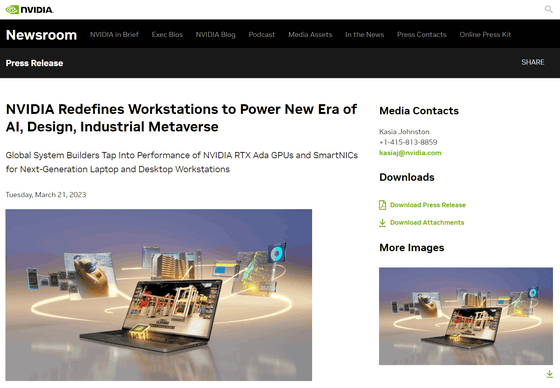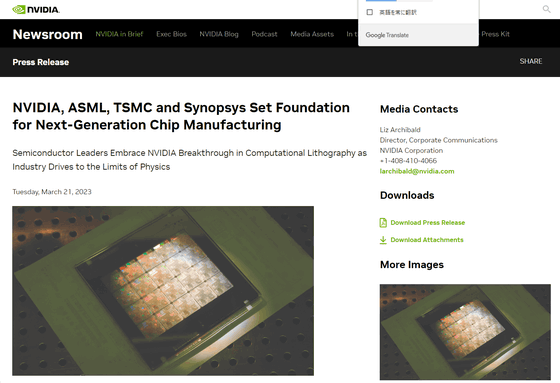NVIDIA announces GPU 'NVIDIA RTX Ada Generation' series with Ada Lovelace architecture for workstations

At the technical conference '
NVIDIA Redefines Workstations to Power New Era of AI, Design, Industrial Metaverse | NVIDIA Newsroom
https://nvidianews.nvidia.com/news/nvidia-redefines-workstations-to-power-new-era-of-ai-design-industrial-metaverse

RTX in Professional Laptops | NVIDIA
https://www.nvidia.com/en-us/design-visualization/rtx-professional-laptops/
RTX 4000 SFF Ada Generation Graphics Card | NVIDIA
https://www.nvidia.com/en-us/design-visualization/rtx-4000-sff/
NVIDIA Unveils Ada Lovelace RTX Workstation GPUs for Laptops; Desktop RTX 4000 SFF
https://www.anandtech.com/show/18781/nvidia-unveils-rtx-ada-lovelace-gpus-for-laptops-desktop-rtx-4000-sff
``NVIDIA RTX Ada Generation GPUs deliver the performance needed for today's highly collaborative content creation, design, and AI workflows,'' said NVIDIA. It claims to offer up to twice the efficiency.
Below is a table summarizing the specifications of 5 models that are GPUs for mobile workstations. The core configuration is almost the same as GeForce RTX 40 Series Laptops, a GPU for notebook PCs.
| NVIDIA RTX 5000 Ada Laptop GPUs | NVIDIA RTX 4000 Ada Laptop GPUs | NVIDIA RTX 3500 Ada Laptop GPUs | NVIDIA RTX 3000 Ada Laptop GPUs | NVIDIA RTX 2000 Ada Laptop GPUs | |
| GPUs | AD103 | AD104 | AD104 | AD106 | AD106 |
| architecture | Ada Lovelace | Ada Lovelace | Ada Lovelace | Ada Lovelace | Ada Lovelace |
| process | TSMC 4N | TSMC 4N | TSMC 4N | TSMC 4N | TSMC 4N |
| SM | 76 units | 58 units | 40 units | 36 units | 24 units |
| CUDA core | 9728 units | 7424 units | 5120 units | 4608 units | 3072 units |
| RT core | 76 units | 58 units | 40 units | 36 units | 24 units |
| Tensor core | 304 units | 232 units | 160 units | 144 units | 96 units |
| boost clock | Up to 2.19GHz | Up to 2.26GHz | Up to 2.25GHz | Up to 2.16GHz | Up to 2.36GHz |
| VRAM | 16GB GDDR6 ECC | 12GB GDDR6 ECC | 12GB GDDR6 ECC | 8GB GDDR6 ECC | 16GB GDDR6 ECC |
| memory bus width | 256 bits | 192 bits | 192 bits | 128 bits | 128 bits |
| memory bandwidth | Up to 576GB/s | up to 432GB/s | up to 432GB/s | Up to 256GB/s | Up to 256GB/s |
| PCIe | 4.0 | 4.0 | 4.0 | 4.0 | 4.0 |
| FP32 performance | 42.6 FLOPS | 33.6 FLOPS | 23 FLOPS | 19.9 FLOPS | 14.5 FLOPS |
| NVENC/NVDEC | twenty two | twenty two | twenty one | 1/1 | 1/1 |
| total power consumption | 80-150 W + 25 W Dynamic Boost | 60-150 W + 25 W Dynamic Boost | 60-115 W + 25 W Dynamic Boost | 35-150 W + 25 W Dynamic Boost | 35-115 W + 25 W Dynamic Boost |
According to NVIDIA, the RT core is the 3rd generation, the Tensor core is the 4th generation, and the performance has improved up to twice as much as the previous generation. Mobile workstations equipped with the NVIDIA RTX Ada Generation series are expected to be released in March 2023.

A demo movie of NVIDIA RTX Ada Generation for mobile workstations can be seen from the following.
And the specifications of the two models that are GPUs for desktop workstations are as follows.
| RTX 4000 SFF Ada Generation | |
| GPUs | AD104 |
| architecture | Ada Lovelace |
| process | TSMC 4N |
| SM | 48 units |
| CUDA core | 6144 units |
| RT core | 48 units |
| Tensor core | 192 units |
| boost clock | Up to 1.56GHz |
| VRAM | 20GB GDDR6 ECC |
| memory bus width | 160 bits |
| memory bandwidth | up to 432GB/s |
| PCIe | Gen 4 x 16 |
| DisplayPort | mini DisplayPort 1.4a x 4 |
| FP32 performance | 19.2 FLOPS |
| NVENC/NVDEC | twenty two |
| thermal design power | 70W |
| launch price | $ 1250 (about 165,000 yen) |
The RTX 4000 SFF Ada Generation is the second GPU for desktop workstations that uses the Ada Lovelace architecture, following the 'RTX 6000 Ada Generation' released in January 2023. The RTX 4000 SFF Ada Generation has a TDP of 70W, which consumes much less power than the RTX 6000 Ada Generation, which is said to have a TDP of 300W. It can be said that it is a model for users who do not need a GPU. NVIDIA has announced that next-generation desktop workstations with RTX 4000 SFF Ada Generation will appear from BOXX, HP, Lenovo and others from March 2023.

In addition, NVIDIA announced that it is developing a software library 'cuLitho' for semiconductor manufacturing in collaboration with TSMC, ASML, and Synopsys.
NVIDIA, ASML, TSMC and Synopsys Set Foundation for Next-Generation Chip Manufacturing | NVIDIA Newsroom
https://nvidianews.nvidia.com/news/nvidia-asml-tsmc-and-synopsys-set-foundation-for-next-generation-chip-manufacturing

This cuLitho is an AI-based technology that achieves a performance leap of up to 40 times in lithography that engraves circuit patterns on silicon wafers, and improves power efficiency by 9 times. 'The chip industry is the foundation of almost every other industry in the world,' said NVIDIA CEO Jensen Huang. Developing cuLitho will enable semiconductor fabs to increase the efficiency of chip manufacturing below 2nm and reduce their carbon footprint.'
Related Posts:







